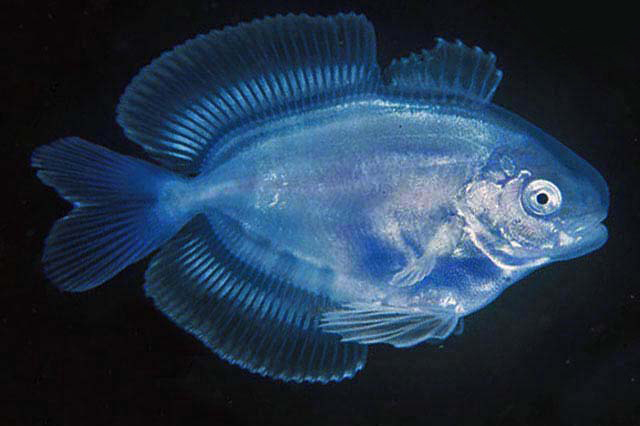- Classification
- ACTINOPTERYGII
- PERCIFORMES
- NOMEIDAE
- Psenes
- pellucidus
Blackrag, Psenes pellucidus Lütken 1880
Other Names: Bluefin Driftfish, Eyebrow Fish, Harvest Fish, Lord Howe Island Harvest-Fish, Scissortail, Short-finned Trevalla

A juvenile Blackrag, Psenes pellucidus, in Japan. Source: Fishpix (http://fishpix.kahaku.go.jp/) / via Shorefishes of the Eastern Tropical Pacific. License: CC by Attribution-NonCommercial-ShareAlike
Summary:
A dark brown to purplish-black driftfish with a dark blue eye, and an elongate compressed flabby body with a blunt snout and a forked tail. The deeper bodied pelagic juveniles are a translucent silvery-blue with broad dark blue bands along the dorsal and anal fins.
Cite this page as:
Bray, D.J. 2020, Psenes pellucidus in Fishes of Australia, accessed 01 Jul 2025, https://fishesofaustralia.net.au/home/species/1207
Blackrag, Psenes pellucidus Lütken 1880
More Info
|
Distribution |
Newcastle, New South Wales, to off South Australia, and south to east of Bicheno Tasmania; also the Lord Howe Province and the Cascade Plateau, in the Tasman Sea. Elsewhere the species is circumglobal in tropical and subtropical seas. Lives in association with jellyfishes and floating Sargassum and undertakes diurnal vertical migrations. Adults are meso- to benthopelagic over the continental slope, seamounts, ridges and rises. |
|
Features |
Dorsal fin. IX-XII + I, 27-32; Anal fin III, 26-31; Caudal fin 17; Pectoral fin 18-20; Pelvic fin I, 5; Lateral line approx. 115-125; Gill rakers 8-9 + 1 + 14-16; Vertebrae 41-42. Body elongate, moderately deep (31-41% SL), strongly compressed; caudal peduncle short and slender; musculature soft and flabby. Head large (25-39% SL), compressed; snout blunt, almost truncated; eyes large (23-28% HL), set deep into head; mouth of moderate size, maxillae not quite reaching below front of eyes, barely oblique; teeth in upper jaw fang like and widely spaced, those in lower jaw close set and finely serrate, each jaw with single row, small teeth on vomer but none on tongue. Scales very small and easily dislodged, extending forward on head to between orbits; lateral line close to and following profile of back. Numerous small pores on head. Two dorsal fins, first dorsal membranous with slender spines, high and rounded, originating above pectoral fin bases; second dorsal long, of moderate height, outer margin rounded, about parallel with profile of back; anal fin similar to and opposite second dorsal; caudal fin distinctly forked, fin tips pointed. Pectoral fins moderately small, rounded, paddle shaped. Pelvic fins of moderate size, thoracic. |
|
Feeding |
Feeds on zooplankton and small pelagic fishes. |
|
Etymology |
The specific name is from the Latin pellucidus (= transparent, clear) in reference to the almost transparent juveniles of this species. |
|
Species Citation |
Psenes pellucidus Lutken, 1880, Dansk. Viol. Selsk. Skrift., Kjobenhavn (5)12(6): 516, fig. 601. Type locality: Surabaja Strait, Java Sea. |
|
Author |
Bray, D.J. 2020 |
|
Resources |
Blackrag, Psenes pellucidus Lütken 1880
References
Allen, G.R., Hoese, D.F., Paxton, J.R., Randall, J.E., Russell, B.C., Starck, W.A., Talbot, F.H. & Whitley, G.P. 1976. Annotated checklist of the fishes of Lord Howe Island. Records of the Australian Museum 30(15): 365-454 figs 1-2
Dooley, J., Marechal, J., Pina Amargos, F., Aiken, K.A., Collette, B.B., Singh-Renton, S. & Kishore, R. 2015. Psenes pellucidus (errata version published in 2017). The IUCN Red List of Threatened Species 2015: e.T16545256A115362452. https://dx.doi.org/10.2305/IUCN.UK.2015-4.RLTS.T16545256A16546214.en. Downloaded on 06 October 2020.
Gloerfelt-Tarp, T. & Kailola, P.J. 1984. Trawled Fishes of Southern Indonesia and Northwest Australia. Jakarta : Dir. Gen. Fish. (Indonesia), German Tech. Coop., Aust. Dev. Ass. Bur. 406 pp.
Gomon, M.F. & Last, P.R. 2008. Family Nomeidae. pp. 801-804 in Gomon, M.F., Bray, D.J. & Kuiter, R.H. (eds). Fishes of Australia's Southern Coast. Sydney : Reed New Holland 928 pp.
Gulyugin, S.Y. & Kukuev, E.I. 2010. On a mass catch of Adult Psenes pellucidus (Nomeidae, Perciformes) in waters of the Islamic Republic of Mauritania. Journal of Ichthyology 50(9): 819-822.
Haedrich, R.L. 1967. The stromateoid fishes; systematics and a classification. Bulletin of the Museum of Comparative Zoology, Harvard 135(2): 31-139 figs 1-56 See ref at BHL
Last, P.R. 2001. Nomeidae, Ariommatidae, Tetragonuridae. pp. 3771-3785 in Carpenter, K.E. & Niem, T.H. (eds). The Living Marine Resources of the Western Central Pacific. FAO Species Identification Guide for Fisheries Purposes. Rome : FAO Vol. 6 pp. 3381-4218.
Lütken, C.F. 1880. Spolia Atlantica. Bidrag til Kundskab om Formforandringer hos Fiske under deres Vaext og Udvikling, saerligt hos nogle af Atlanterhavets Højsøfiske. Det Kongelige Danske Videnskabernes Selskabs Skrifter, Naturvidenskabelig og mathematisk afdeling, Kjøbenhavn (5)12: 409-613, Pls. 1-5.
May, J.L. & Maxwell, J.G.H. 1986. Field Guide to Trawl Fish from Temperate Waters of Australia. Hobart : CSIRO Division of Marine Research 492 pp.
McDowall, R.M. 1994. Family Nomeidae. pp. 839-843, figs 742-745 in Gomon, M.F., Glover, C.J.M. & Kuiter, R.H. (eds). The Fishes of Australia's South Coast. Adelaide : State Printer 992 pp. 810 figs.
Parin, N.V. & Piotrovsky, A.S. 2004. Stromateoid fishes (suborder Stromateoidei) of the Indian Ocean (species composition, distribution, biology, and fisheries). Journal of Ichthyology 44(Suppl. 1): 33-62.
Stewart, A.L. & Last, P.R. 201. 236 Family Nomeidae. pp. 1662-1667 in Roberts, C.D., Stewart, A.L. & Struthers, C.D. (eds). The Fishes of New Zealand. Wellington : Te Papa Press Vol. 4 pp. 1153-1748.
Whitley, G.P. 1948. Studies in Ichthyology No. 13. Records of the Australian Museum 22(1): 70-94 figs 1-11 DOI: 10.3853/j.0067-1975.22.1948.592 (described as Caristiodes amplipinnis)
Whitley, G.P. 1958. Descriptions and records of fishes. Proceedings of the Royal Zoological Society of New South Wales 1956–57: 28-51 figs 1-12 (described as Seriolella noel) See ref at BHL





